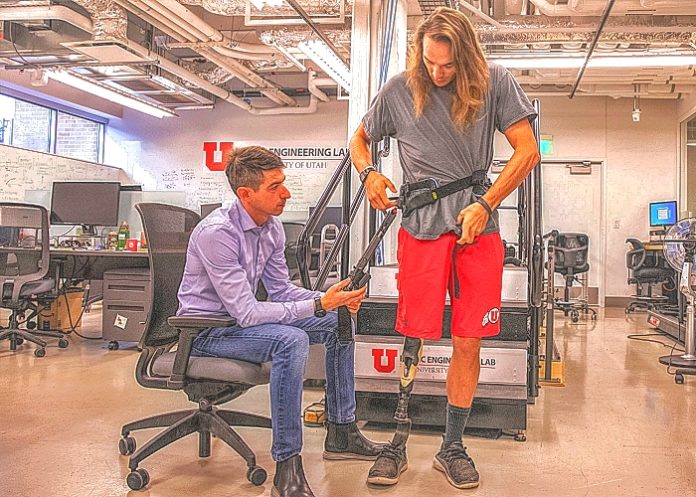An autonomous, powered hip exoskeleton capable of improving walking for people with above-knee amputation has been presented in an early-stage clinical study published in Nature Medicine.
For the millions of people with above-knee amputation, walking with leg prostheses currently available is highly energy inefficient, which limits their mobility.
Autonomously powered hip exoskeletons have been shown to reduce the metabolic cost of — or the energy demands associated with — walking in young people who have not undergone amputation. However, their use by people with above-knee amputation has not yet been tested.
Tommaso Lenzi and colleagues from the University of Utah tested the efficacy of a powered hip exoskeleton for six people (four male, two female; average age of 33.8 years) with above-knee amputation, as they walked on a treadmill at a speed of 1 metre per second and also as they walked on a 12m walkway. The authors found that compared with the metabolic cost of using a standard prosthesis, using the hip exoskeleton, on average, reduced the metabolic cost of walking by 15.6%. This improvement is equivalent to removing a 12kg backpack from a person who has not undergone amputation. All participants were additionally able to walk with the exoskeleton without a negative effect on their gait.
The authors indicate the need for future clinical studies to optimise the device and to assess its efficacy for people with different types of amputation and with varying potential for rehabilitation.
Study details
Powered hip exoskeleton improves walking economy in individuals with above-knee amputation
Marshall K. Ishmael, Dante Archangeli & Tommaso Lenzi, Department of Mechanical Engineering and Robotics University of Utah, Salt Lake City,
Published in Nature Medicine on 11 October 2021
Abstract
Above-knee amputation severely reduces the mobility and quality of life of millions of individuals. Walking with available leg prostheses is highly inefficient, and poor walking economy is a major problem limiting mobility.
Here we show that an autonomous powered hip exoskeleton assisting the residual limb significantly improves metabolic walking economy by 15.6 ± 2.9% (mean ± s.e.m.; two-tailed paired t-test, P = 0.002) in six individuals with above-knee amputation walking on a treadmill. The observed metabolic cost improvement is equivalent to removing a 12-kg backpack from a nonamputee individual. All participants were able to walk overground with the exoskeleton, including starting and stopping, without notable changes in gait balance or stability.
This study shows that assistance of the user’s residual limb with a powered hip exoskeleton is a viable solution for improving amputee walking economy. By significantly reducing the metabolic cost of walking, the proposed hip exoskeleton may have a considerable positive impact on mobility, improving the quality of life of individuals with above-knee amputations.
See more from MedicalBrief archives:
Exoskeletons to help disabled people to walk
AI-driven exoskeleton lets quadriplegic man walk again
Ankle exoskeleton enables significantly faster walking
Wits engineering students lend a hand with cheaper prosthetics

